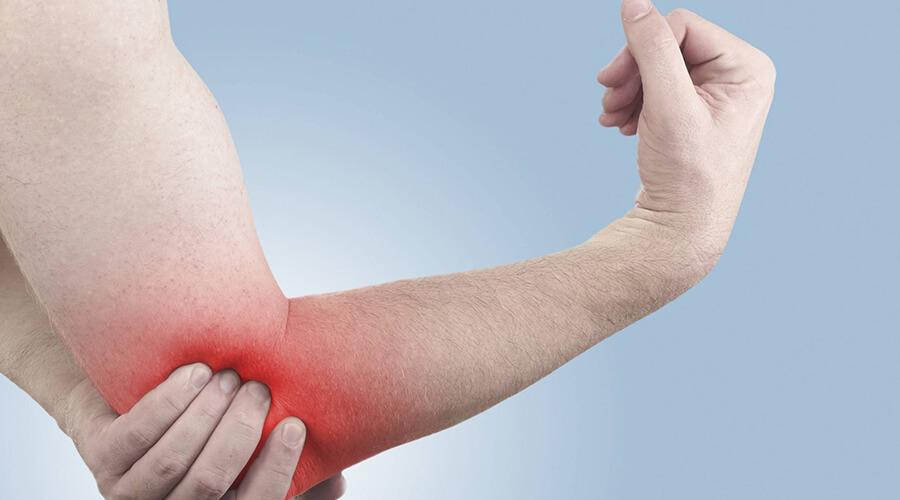
There are many different causes of elbow pain, including tennis elbow, articular cartilage damage and bone fractures, which can cause inflammation and pain.
Unpleasant sensations may also be associated with inflammation such as numbness.
Let’s look at the possible causes of elbow arthritis!
Bone ends meet in the elbow joint and, in addition to their articular surfaces, the joint is made up of articular cartilage, tendons, synovial fluid, synovial capsule and, of course, ligaments. If there is nothing wrong with the elbow joint, the arm can be bent and stretched and the head of the hand can rotate without any problems. If the elbow is very painful, it is usually due to damage to the joint structure.
The elbow joint is usually subjected to a lot of stress every day, either during normal physical activity or during sport.
Elbow inflammation is often caused by a faulty load or injury. Temporary elbow pain can also be caused by long periods of rest, for example from a possible fracture due to a cast. It is important to know that if the pain does not go away after the cast is removed, you should see a doctor immediately.
Elbow pain can be acute or chronic. The elbow may also have stabbing, pressing or pulling pain. Often the pain is accompanied by limited movement or possible inflammation. When the elbow is inflamed, it feels warm to the touch.
Symptoms of elbow arthritis
Pain: One of the most common symptoms is pain, which can occur both at rest and during movement. Pain can be dull or sharp and is often felt on the outside or inside of the elbow.
Swelling: Swelling of the tissues around the joint is common. This swelling can be both visible and palpable.
Stiffness: stiffness of the joint, especially in the morning or after prolonged rest. Stiffness can make it difficult to move the arm and bend or stretch the elbow.
Redness and warmth: The skin of the affected area may be red and warm to the touch. This is a sign of inflammation.
Decreased range of motion: Arthritis can limit the elbow’s range of motion, which can make it difficult to carry out everyday activities.
Cracking sounds: when moving, there may be knocking or clicking sounds in the joint, which may be a sign of joint damage.
Weakness: Weakness in the affected arm which may make it difficult to lift or hold objects.
Treatment for elbow arthritis always depends on what has caused the elbow pain.
Acute elbow pain that may be caused by a load usually resolves itself. The cause of the elbow inflammation will also determine whether hot or cold treatment is needed. If it is tennis elbow, it is best to use products made from natural ingredients. In this case, you should definitely try HillVital Maximum Balm which contains 19 great herbs and has a very strong effect due to its high herbal content. Specific ingredients include arnica, goose pimpernel and rosemary. These are all among the best anti-inflammatory herbs.
What is elbow tendonitis?
Elbow bursitis, also known medically as olecranon bursitis, is a condition that affects the mucus sac (bursa) at the back of the elbow. The bursa is a fluid-filled sac around the joints that helps reduce friction between bones, tendons and muscles.
What are the possible causes of right elbow pain?
Overuse or repetitive movements: frequent repetitive movements, such as using a mouse or playing a sport that requires elbow movement, can overuse the joint and surrounding tissues, which can cause pain. It can easily lead to right or left elbow pain.
Tennis elbow: This is a condition in which the tendons and muscles around the joint become irritated or inflamed, usually in the small bumps on the elbow, in the lateral area. Although named after tennis players, it can also be triggered by other activities. It is also a common cause of left or right elbow pain.
Golf elbow:- This is another tendon and muscle problem that occurs in the area on the other side of the joint. It is often caused by activities related to bending the arm and applying force.
Arthritis: Conditions such as osteoarthritis or rheumatoid arthritis can affect the elbow joint and cause pain and stiffness.
Bursitis: the bursa is a small, sac-like structure that reduces friction in the joints. When the bursa at the elbow becomes irritated or inflamed, bursitis can occur, causing pain and swelling.
Fractures or injuries: injuries, bruises or fractures of the elbow bones or ligaments around the elbow can cause pain and limited mobility.
Nerve problems: Pinched or irritated nerves can also cause pain in the elbow and even numbness or weakness.
How is it recommended to treat elbow pain at home?
Rest and relaxation: the first step is to rest the sore limb. Avoid activities that can cause additional stress on the elbow joint.
Jelling: Jelling the sore area can help reduce swelling and inflammation. Ice the elbow for 15-20 minutes and repeat a few times a day.
Compression: use a compression bandage around the elbow to reduce swelling and support the joint.
Elevation: Whenever possible, keep the painful limb elevated to reduce swelling.
Painkillers: non-prescription painkillers can help relieve pain and reduce inflammation. However, always follow the dosage instructions and consult your doctor if you are taking other medicines.
Stretching and strengthening: specific stretching and strengthening exercises can be done around the elbow joint. These can help reduce tension and strengthen muscles. For example, for tennis elbows, strengthening the flexors and extensors may be helpful.
Massage: Mild massage can also help relieve tension and increase circulation to the sore area.
Hand and elbow pads: use special pads or elbow pads for sleeping at night to minimise night-time pain and stress.



